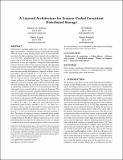A Layered Architecture for Erasure-Coded Consistent Distributed Storage
Author(s)
Konwar, Kishori M.; Prakash, N.; Lynch, Nancy; Médard, Muriel
DownloadAccepted version (1.181Mb)
Open Access Policy
Open Access Policy
Creative Commons Attribution-Noncommercial-Share Alike
Terms of use
Metadata
Show full item recordAbstract
© 2017 Association for Computing Machinery. Motivated by emerging applications to the edge computing paradigm, we introduce a two-layer erasure-coded fault-tolerant distributed storage system offering atomic access for read and write operations. In edge computing, clients interact with an edge-layer of servers that is geographically near; the edge-layer in turn interacts with a back-end layer of servers. The edge-layer provides low latency access and temporary storage for client operations, and uses the back-end layer for persistent storage. Our algorithm, termed Layered Data Storage (LDS) algorithm, offers several features suitable for edge-computing systems, works under asynchronous message-passing environments, supports multiple readers and writers, and can tolerate f1 < n1/2 and f2 < n2/3 crash failures in the two layers having n1 and n2 servers, respectively. We use a class of erasure codes known as regenerating codes for storage of data in the back-end layer. The choice of regenerating codes, instead of popular choices like Reed-Solomon codes, not only optimizes the cost of back-end storage, but also helps in optimizing communication cost of read operations, when the value needs to be recreated all the way from the back-end. The two-layer architecture permits a modular implementation of atomicity and erasure-code protocols; the implementation of erasurecodes is mostly limited to interaction between the two layers. We prove liveness and atomicity of LDS, and also compute performance costs associated with read and write operations. In a system with n1 = Θ(n2), f1 = Θ(n1), f2 = Θ(n2), the write and read costs are respectively given by Θ(n1) and Θ(1) + n1I(δ > 0). Here δ is a parameter closely related to the number of write operations that are concurrent with the read operation, and I(δ > 0) is 1 if δ > 0, and 0 if δ = 0. The cost of persistent storage in the back-end layer is Θ(1). The impact of temporary storage is minimally felt in a multiobject system running N independent instances of LDS, where only a small fraction of the objects undergo concurrent accesses at any point during the execution. For the multi-object system, we identify a condition on the rate of concurrent writes in the system such that the overall storage cost is dominated by that of persistent storage in the back-end layer, and is given by Θ(N).
Date issued
2017-07-25Department
Massachusetts Institute of Technology. Department of Electrical Engineering and Computer SciencePublisher
ACM
Citation
Konwar, Kishori M., Prakash, N., Lynch, Nancy and Médard, Muriel. 2017. "A Layered Architecture for Erasure-Coded Consistent Distributed Storage."
Version: Author's final manuscript